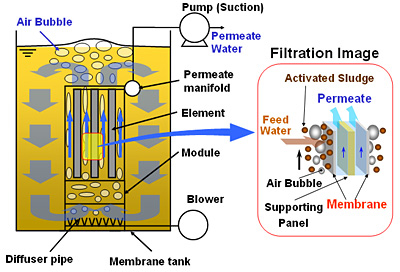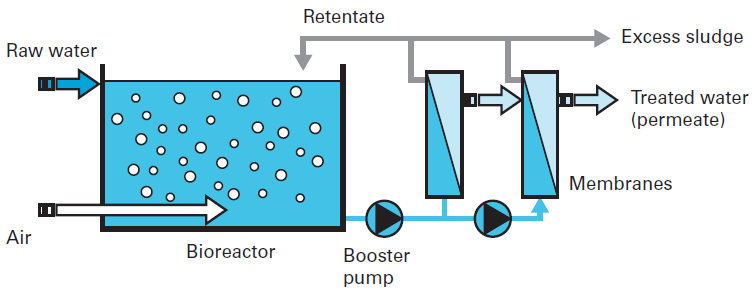Exploring the Benefits of Membrane Bioreactor in Municipal Wastewater Plants
Exploring the Benefits of Membrane Bioreactor in Municipal Wastewater Plants
Blog Article
Just How Membrane Layer Bioreactors Are Transforming Water Filtration Solutions
The emergence of membrane layer bioreactors (MBRs) stands for a significant improvement in the field of water filtration, merging biological therapy procedures with sophisticated membrane layer purification modern technologies. As international water shortage increases, the function of MBRs in facilitating drinkable water reuse and sustainable water monitoring becomes increasingly crucial.
Summary of Membrane Layer Bioreactors
Membrane bioreactors (MBRs) represent a considerable innovation in water filtration innovation, as they combine biological therapy processes with membrane filtering. This combination improves the efficiency of wastewater treatment by utilizing microorganisms to degrade natural pollutants while all at once employing semi-permeable membrane layers to separate treated water from put on hold virus and solids.
The MBR system generally includes an organic activator where the microbial populace metabolizes contaminants, followed by a membrane filtration system that maintains biomass and allows just clean water to pass through. This twin performance results in higher effluent top quality contrasted to conventional therapy techniques. MBRs can be operated in both set and continuous circulation settings, providing adaptability in layout and application.
They also enable the recuperation of water for reuse, hence adding to water sustainability campaigns. On the whole, MBRs are at the center of improving water treatment efficiency and quality, showcasing the potential for innovative solutions in ecological monitoring.
Benefits of MBR Innovation
The assimilation of organic treatment with membrane layer filtration uses numerous benefits for water purification processes. One of the main advantages of Membrane Bioreactor (MBR) innovation is its capability to effectively eliminate both natural and not natural contaminants, causing top notch effluent. The membranes work as a physical barrier, avoiding suspended solids and virus from going through, which enhances the general security and integrity of cured water.
Additionally, MBR systems require a smaller footprint compared to conventional therapy approaches, permitting more reliable space application. This portable style is specifically advantageous in city setups where land is restricted. MBRs also demonstrate functional adaptability, accommodating differing influent qualities and flow prices without substantial performance degradation.
Furthermore, the procedure offers boosted nutrient removal capabilities, specifically for nitrogen and phosphorus, which are vital for stopping eutrophication in getting waters. The reduced sludge manufacturing linked with MBR innovation also translates to lower disposal costs, making it a cost-efficient solution in the long run - Membrane Bioreactor. On the whole, the advantages of MBR technology position it as a leading choice for cutting-edge and sustainable water filtration systems, addressing both environmental and economic concerns
Applications in Water Purification
Applications of Membrane Bioreactor (MBR) technology in water filtration are impactful and diverse, dealing with different treatment needs across numerous sectors. MBRs efficiently integrate organic treatment processes with membrane layer purification, making them suitable for community wastewater treatment, commercial effluent administration, and also safe and clean water reuse initiatives.
In municipal setups, MBRs are progressively utilized to improve the top quality of dealt with wastewater, permitting for conformity with rigid discharge guidelines and facilitating the recycling of water for watering and non-potable uses. Their small layout additionally makes them suitable for urban atmospheres where area is restricted.
Industrially, MBR technology is made use of to deal with procedure water and wastewater, especially in markets such as food and drink, pharmaceuticals, and textiles. By properly removing impurities and put on hold solids, MBRs help sectors reduce ecological effects while recovering valuable resources from wastewater streams.
Moreover, MBRs are acquiring traction in decentralized water therapy applications, where small systems can be deployed in remote areas or establishing areas. This versatility makes it possible for communities to accomplish sustainable water monitoring solutions, improving access to tidy water while minimizing reliance on standard treatment techniques.
Study and Success Stories

In one more instance, a fabric manufacturing facility in Bangladesh took on MBR technology to resolve its wastewater challenges. The system lowered chemical oxygen need (COD) levels from 1,200 mg/L to less than 100 mg/L, thus satisfying regulatory criteria and substantially minimizing ecological impact.
The College of Cape Town's MBR installation has shown effective in treating greywater for non-potable reuse on campus. This project not only conserves potable water but likewise works as an academic model for sustainable methods.
Additionally, a seafood processing plant in Norway utilized MBR modern technology to deal with effluents having high degrees of natural matter, accomplishing over 90% pollutant elimination. These study highlight MBR modern technology's convenience and its essential function in boosting water top quality throughout diverse applications.
Future of Water Treatment Solutions
As worldwide water deficiency and contamination difficulties heighten, cutting-edge water therapy options are coming to be increasingly necessary to guarantee sustainable accessibility to clean water. The future of water therapy lies in the assimilation of sophisticated modern technologies that improve the performance and effectiveness of purification procedures. Membrane layer bioreactors (MBRs) are at the go to the website leading edge of this development, integrating biological therapy with membrane layer filtration to produce high-grade effluent appropriate for different applications.

Emerging fads such as source recovery from wastewater, consisting of nutrients and energy, will certainly better transform therapy centers right into environmentally friendly hubs. Improvements in nanotechnology and membrane layer products assure enhanced performance and longevity of purification systems.

Final Thought
To conclude, membrane layer bioreactors stand for a significant development in water filtration technologies, effectively incorporating biological treatment with innovative membrane filtration. The countless advantages, including boosted effluent high quality and minimized spatial demands, make MBRs particularly suitable for city applications. Their role in safe and clean water reuse and lasting water monitoring highlights their value in dealing with additional resources international water scarcity difficulties. Continued study and advancement will additionally enhance the effectiveness and adoption of MBR innovation, making certain a resilient future for water treatment solutions.
The emergence of membrane layer bioreactors (MBRs) represents a significant improvement in the area of water filtration, combining biological therapy procedures with innovative membrane layer filtration technologies. As international water shortage magnifies, the role of MBRs in facilitating potable water reuse and sustainable water monitoring ends up being progressively vital. They likewise make it possible for the recuperation of water for reuse, hence contributing to water sustainability efforts.As global water scarcity and pollution challenges intensify, cutting-edge water therapy services are ending up being increasingly important to guarantee lasting access to clean water. Their role in potable water reuse and lasting water management highlights their significance in resolving worldwide water scarcity difficulties.
Report this page